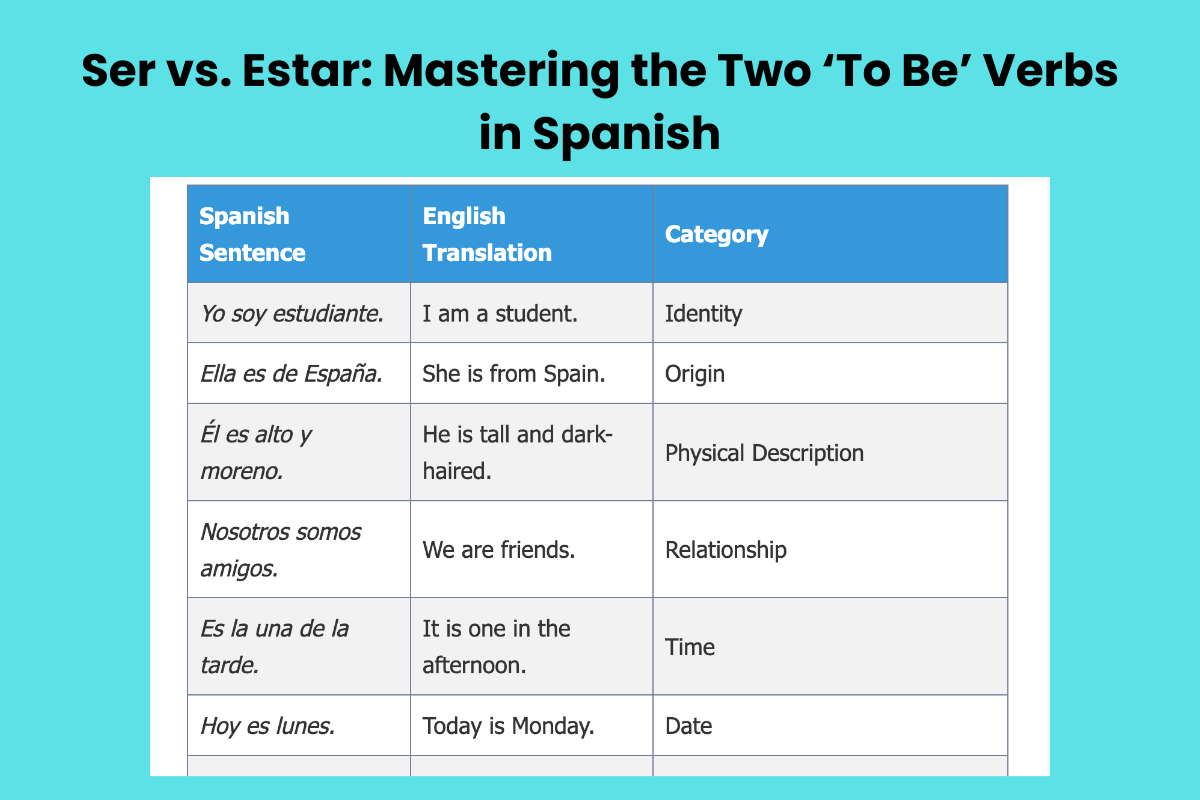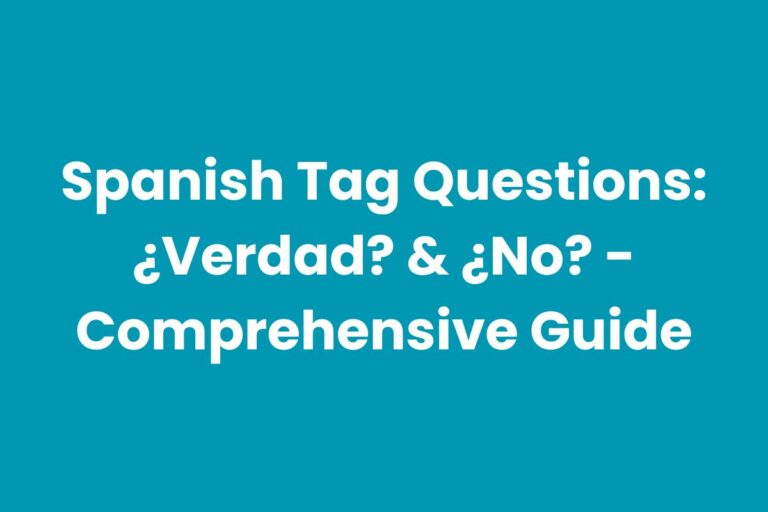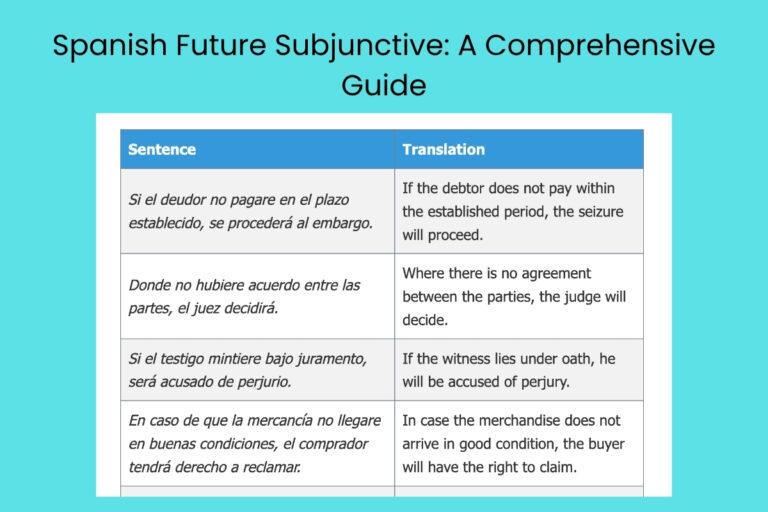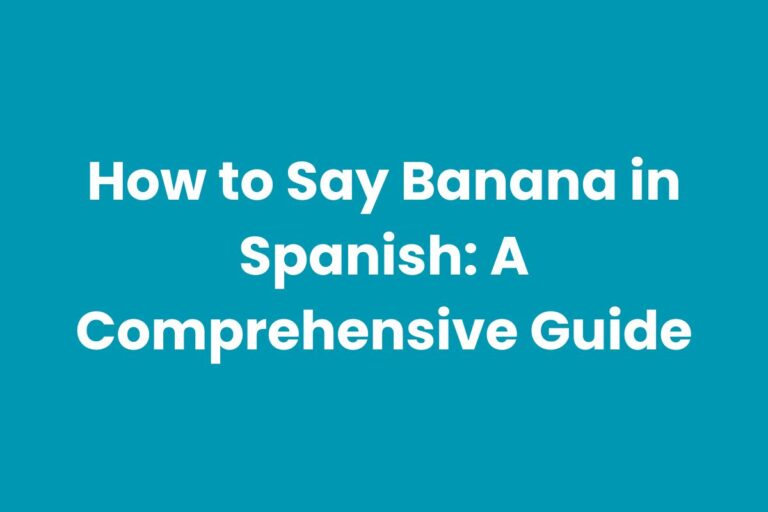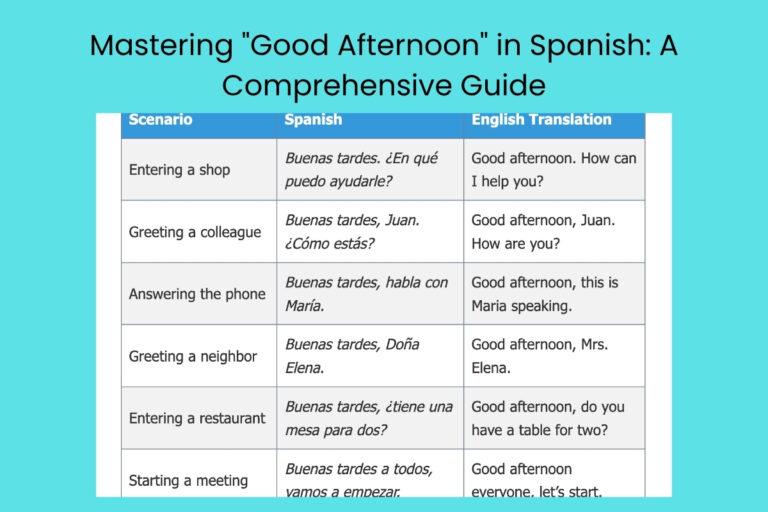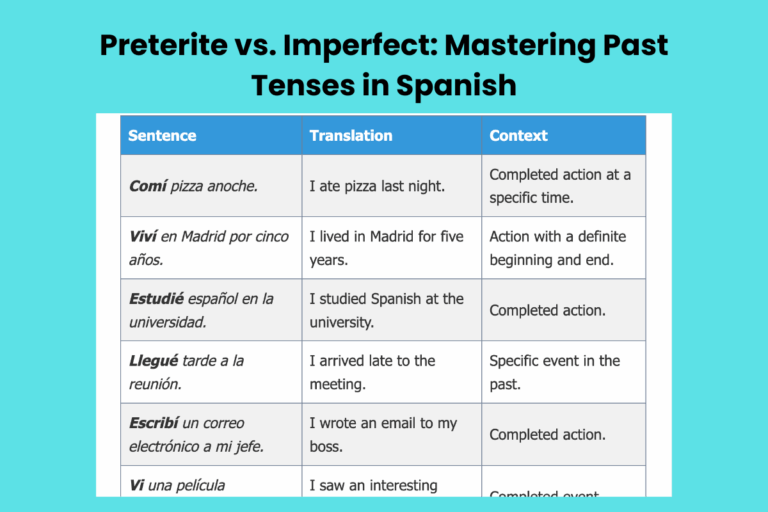Ser vs. Estar: Mastering the Two ‘To Be’ Verbs in Spanish
Understanding the difference between ser and estar, both translating to “to be” in English, is crucial for mastering Spanish. These verbs are not interchangeable, and using the wrong one can significantly alter the meaning of your sentences. This article provides a comprehensive guide to distinguishing between ser and estar, covering their definitions, structural uses, specific applications, and common pitfalls. Whether you’re a beginner or an advanced learner, this guide will equip you with the knowledge and practice needed to confidently navigate these essential Spanish verbs.
This guide is designed for English speakers learning Spanish at any level. It provides detailed explanations, numerous examples, and practical exercises, ensuring a solid understanding of when to use ser and when to use estar. By the end of this article, you’ll be able to construct grammatically correct and meaningful sentences in Spanish, avoiding common errors and communicating effectively.
Table of Contents
- Definition of Ser and Estar
- Structural Breakdown
- Types and Categories of Usage
- Examples of Ser and Estar
- Usage Rules
- Common Mistakes
- Practice Exercises
- Advanced Topics
- FAQ
- Conclusion
Definition of Ser and Estar
Both ser and estar are Spanish verbs that translate to the English verb “to be.” However, they are used in different contexts to convey different types of information. Understanding their distinct meanings is fundamental to speaking and writing correctly in Spanish. Ser generally describes permanent or inherent characteristics, while estar describes temporary states, conditions, or locations. This fundamental difference dictates their usage in various sentence structures.
Ser is used to express identity, origin, characteristics, time, and relationships. It describes what something *is* in its essence. This encompasses qualities that are generally considered unchanging or defining. For example, nationality, profession, physical descriptions, and inherent traits are all expressed using ser. Think of ser as defining the fundamental nature of something or someone.
Estar, on the other hand, is used to express temporary states, conditions, emotions, and locations. It describes how something *is* at a particular moment or in a specific situation. This includes feelings, physical conditions, locations, and progressive tenses. Consider estar as describing a temporary or changeable state.
Structural Breakdown
The structure of sentences using ser and estar generally follows the pattern: Subject + Verb (ser/estar) + Complement. The complement provides additional information about the subject. The choice of verb (ser or estar) depends on the type of information being conveyed. Conjugation of the verbs must match the subject pronoun.
The conjugations of ser and estar in the present tense are as follows:
| Pronoun | Ser | Estar |
|---|---|---|
| Yo (I) | Soy | Estoy |
| Tú (You, informal) | Eres | Estás |
| Él/Ella/Usted (He/She/You, formal) | Es | Está |
| Nosotros/Nosotras (We) | Somos | Estamos |
| Vosotros/Vosotras (You, informal plural – Spain) | Sois | Estáis |
| Ellos/Ellas/Ustedes (They/You, formal plural) | Son | Están |
Understanding these conjugations is essential for constructing grammatically correct sentences. The choice of ser or estar and the correct conjugation are crucial for conveying the intended meaning. For example, “Yo soy estudiante” (I am a student) uses ser to indicate a permanent identity, while “Yo estoy cansado” (I am tired) uses estar to indicate a temporary state.
Types and Categories of Usage
The distinction between ser and estar can be further understood by categorizing their specific uses. Ser is typically used for permanent or inherent characteristics, while estar is used for temporary states or conditions. These categories provide a framework for determining which verb to use in different situations.
Ser: Permanent or Inherent Characteristics
Ser is used to describe characteristics that are generally considered permanent or inherent to the subject. These include:
- Identity and Origin: Name, nationality, profession, and origin.
- Physical Descriptions: Physical attributes that are generally unchanging.
- Personality Traits: Inherent personality characteristics.
- Time and Date: Telling time, dates, and days of the week.
- Relationships: Family relationships and friendships.
- Possession: Indicating ownership.
- Material: What something is made of.
Estar: Temporary States or Conditions
Estar is used to describe states or conditions that are temporary or subject to change. These include:
- Location: The current location of a person or object.
- Emotional States: Feelings and emotions.
- Physical Conditions: Temporary physical states.
- Progressive Tenses: Actions in progress (using the gerund).
- Resulting States: Conditions resulting from an action.
Examples of Ser and Estar
To further illustrate the difference between ser and estar, here are examples categorized by their specific uses. These examples demonstrate how the choice of verb affects the meaning of the sentence.
Ser Examples
The following table provides examples of sentences using ser to describe permanent or inherent characteristics.
| Spanish Sentence | English Translation | Category |
|---|---|---|
| Yo soy estudiante. | I am a student. | Identity |
| Ella es de España. | She is from Spain. | Origin |
| Él es alto y moreno. | He is tall and dark-haired. | Physical Description |
| Nosotros somos amigos. | We are friends. | Relationship |
| Es la una de la tarde. | It is one in the afternoon. | Time |
| Hoy es lunes. | Today is Monday. | Date |
| El libro es de Juan. | The book belongs to Juan. | Possession |
| La mesa es de madera. | The table is made of wood. | Material |
| Mi madre es muy inteligente. | My mother is very intelligent. | Characteristic |
| El coche es rojo. | The car is red. | Characteristic |
| La fiesta es en mi casa. | The party is at my house. | Location (defining the permanent location of the event) |
| El problema es que no tengo dinero. | The problem is that I don’t have money. | Definition/Explanation |
| La vida es bella. | Life is beautiful. | General Truth/Characteristic |
| Es importante estudiar. | It is important to study. | General Truth/Characteristic |
| Soy profesor de español. | I am a Spanish teacher. | Profession |
| Ellos son simpáticos. | They are nice. | Personality |
| La casa es grande. | The house is big. | Description |
| El examen es difícil. | The exam is difficult. | Description |
| ¿De quién es este bolígrafo? | Whose pen is this? | Possession |
| La película es interesante. | The movie is interesting. | Characteristic/Opinion |
| El clima es seco en esta región. | The climate is dry in this region. | Characteristic |
| El edificio es antiguo. | The building is old. | Description |
| La verdad es que estoy cansado. | The truth is that I am tired. | Definition/Explanation |
| Este es mi hermano. | This is my brother. | Relationship |
| Somos estudiantes de medicina. | We are medical students. | Identity |
Estar Examples
The following table provides examples of sentences using estar to describe temporary states or conditions.
| Spanish Sentence | English Translation | Category |
|---|---|---|
| Estoy en casa. | I am at home. | Location |
| Ella está contenta. | She is happy. | Emotional State |
| Él está enfermo. | He is sick. | Physical Condition |
| Nosotros estamos comiendo. | We are eating. | Progressive Tense |
| La puerta está abierta. | The door is open. | Resulting State |
| Estoy cansado después del trabajo. | I am tired after work. | Physical Condition |
| Estamos listos para salir. | We are ready to leave. | Condition |
| El libro está en la mesa. | The book is on the table. | Location |
| Ella está viviendo en París. | She is living in Paris. | Location (temporary) |
| Estoy pensando en ti. | I am thinking about you. | Progressive Tense (thinking) |
| Estamos aprendiendo español. | We are learning Spanish. | Progressive Tense (learning) |
| Estoy de acuerdo contigo. | I agree with you. | Condition |
| ¿Cómo estás hoy? | How are you today? | Condition/Feeling |
| La comida está caliente. | The food is hot. | Condition |
| Estoy ocupado ahora. | I am busy now. | Condition |
| Las ventanas están cerradas. | The windows are closed. | Resulting State |
| Estamos preocupados por ti. | We are worried about you. | Emotional State |
| El concierto está siendo grabado. | The concert is being recorded. | Progressive (passive) |
| Estoy trabajando en un proyecto nuevo. | I am working on a new project. | Progressive Tense |
| Estamos celebrando el cumpleaños de María. | We are celebrating Maria’s birthday. | Progressive Tense |
| El perro está durmiendo en el sofá. | The dog is sleeping on the sofa. | Progressive Tense |
| Estoy escuchando música. | I am listening to music. | Progressive Tense |
| Estamos esperando el autobús. | We are waiting for the bus. | Progressive Tense |
| Estoy leyendo un libro interesante. | I am reading an interesting book. | Progressive Tense |
| Estamos viendo una película. | We are watching a movie. | Progressive Tense |
Usage Rules
While the general guidelines for ser and estar are helpful, there are specific rules and exceptions to consider. These rules ensure accurate usage and a deeper understanding of the nuances of these verbs.
Ser Usage Rules
Here are some specific rules for using ser:
- Description: Use ser to describe inherent qualities of a person or thing. El cielo es azul. (The sky is blue.)
- Occupation: Use ser to state someone’s profession or occupation. Soy médico. (I am a doctor.)
- Characteristic: Use ser for personality traits and physical attributes. Ella es inteligente y alta. (She is intelligent and tall.)
- Time and Date: Use ser to tell time, date and day. Es la una. (It is one o’clock.) Hoy es martes. (Today is Tuesday.)
- Origin: Use ser to indicate where someone or something is from. Soy de México. (I am from Mexico.)
- Relationship: Use ser to describe relationships between people. Somos hermanos. (We are siblings.)
- Event Location: Use ser to indicate where an event is *taking place*. La fiesta es en mi casa. (The party is at my house.)
- Passive Voice: Use ser in the passive voice when indicating who or what performed the action. El libro fue escrito por Gabriel García Márquez. (The book was written by Gabriel García Márquez.)
Estar Usage Rules
Here are some specific rules for using estar:
- Location: Use estar to indicate the location of something or someone. Estoy en la biblioteca. (I am in the library.)
- Condition: Use estar for temporary states of being, both physical and emotional. Estoy cansado. (I am tired.) Ella está feliz. (She is happy.)
- Progressive Tense: Use estar with a gerund (-ando/-iendo) to form the present progressive tense. Estoy comiendo. (I am eating.)
- Resulting State: Use estar to describe the state something is in as a result of an action. La puerta está abierta. (The door is open.)
- Idiomatic Expressions: Certain idiomatic expressions require estar. Estoy de acuerdo. (I agree.)
Common Mistakes
One of the most frequent errors in Spanish is using ser when estar is required, or vice versa. These mistakes can often lead to miscommunication or confusion. Understanding these common errors is key to avoiding them.
| Incorrect | Correct | Explanation |
|---|---|---|
| Yo es cansado. | Yo estoy cansado. | Using ser (es) instead of estar (estoy) to describe a temporary state (tiredness). |
| Ella está de España. | Ella es de España. | Using estar (está) instead of ser (es) to indicate origin. |
| Nosotros somos en la casa. | Nosotros estamos en la casa. | Using ser (somos) instead of estar (estamos) to indicate location. |
| El libro es abierto. | El libro está abierto. | Using ser (es) instead of estar (está) to describe the resulting state of the book being open. |
| Soy viviendo en Madrid. | Estoy viviendo en Madrid. | Using ser (soy) instead of estar (estoy) with the gerund (-ando/-iendo) to describe an action in progress (living). |
| La fiesta está a las ocho. | La fiesta es a las ocho. | Using estar (está) instead of ser (es) to indicate the time of an event. |
| El agua es caliente (when you mean “The water is hot right now”). | El agua está caliente. | Using ser (es) instead of estar (está) to describe a temporary condition of the water. Saying “El agua es caliente” implies the water is always hot. |
| Soy feliz hoy. | Estoy feliz hoy. | Using ser (soy) instead of estar (estoy) to describe a temporary emotional state. |
Practice Exercises
These exercises will help you practice distinguishing between ser and estar. Choose the correct verb form for each sentence.
Exercise 1: Ser or Estar?
Choose the correct form of ser or estar to complete each sentence.
| Question | Answer |
|---|---|
| 1. Yo ____ estudiante. | soy |
| 2. Ella ____ en la biblioteca. | está |
| 3. Nosotros ____ amigos. | somos |
| 4. Él ____ cansado. | está |
| 5. Hoy ____ martes. | es |
| 6. El libro ____ de Juan. | es |
| 7. La puerta ____ abierta. | está |
| 8. ¿Cómo ____ tú? | estás |
| 9. Ellos ____ de España. | son |
| 10. Yo ____ comiendo. | estoy |
Exercise 2: Fill in the Blanks
Fill in the blanks with the correct form of ser or estar and provide the English translation.
| Question | Answer | English Translation |
|---|---|---|
| 1. ____ las tres de la tarde. | Son | It is three in the afternoon. |
| 2. Ella ____ muy contenta hoy. | está | She is very happy today. |
| 3. Nosotros ____ aprendiendo español. | estamos | We are learning Spanish. |
| 4. Él ____ profesor de matemáticas. | es | He is a math teacher. |
| 5. ¿Dónde ____ mis llaves? | están | Where are my keys? |
| 6. La casa ____ grande y bonita. | es | The house is big and beautiful. |
| 7. Yo ____ de acuerdo contigo. | estoy | I agree with you. |
| 8. El café ____ caliente. | está | The coffee is hot. |
| 9. Ellos ____ preocupados por el examen. | están | They are worried about the exam. |
| 10. El concierto ____ en el teatro. | es | The concert is at the theater. |
Advanced Topics
For advanced learners, understanding the subtleties of how ser and estar affect the meaning of adjectives is crucial. Certain adjectives change their meaning depending on whether they are used with ser or estar.
Ser/Estar with Adjectives: Meaning Changes
Some adjectives have different meanings depending on whether they are used with ser or estar. This distinction can significantly alter the interpretation of a sentence. For example:
| Adjective | Ser Meaning | Estar Meaning | Example with Ser | Example with Estar |
|---|---|---|---|---|
| Listo/a | Smart, clever | Ready | Ella es lista. (She is smart.) | Ella está lista. (She is ready.) |
| Aburrido/a | Boring | Bored | La clase es aburrida. (The class is boring.) | Estoy aburrido. (I am bored.) |
| Bueno/a | Good (inherently) | Good (taste, health) | Él es un buen hombre. (He is a good man.) | La sopa está buena. (The soup tastes good.) |
| Malo/a | Bad (inherently) | Sick, unwell | Él es un mal hombre. (He is a bad man.) | Estoy malo. (I am sick.) |
| Orgulloso/a | Proud (inherently) | Proud (feeling) | Es orgulloso de su herencia. (He is proud of his heritage.) | Está orgulloso de su hijo. (He is proud of his son.) |
| Callado/a | Quiet (by nature) | Quiet (at the moment) | Él es callado. (He is quiet.) | Él está callado. (He is being quiet.) |
Understanding these nuances is essential for achieving fluency and avoiding misinterpretations. Always consider the context and the intended meaning when choosing between ser and estar with these adjectives.
FAQ
Here are some frequently asked questions about ser and estar:
- Q: How can I easily remember when to use ser vs. estar?
A: A helpful mnemonic is “DOCTOR” for ser (Description, Occupation, Characteristic, Time, Origin, Relationship) and “PLACE” for estar (Position, Location, Action, Condition, Emotion). Use these acronyms as a starting point and then consider the context of your sentence.
- Q: Are there any exceptions to the rules of ser and estar?
A: Yes, there are some exceptions, particularly with adjectives that change meaning depending on whether they are used with ser or estar. It’s important to learn these specific cases through practice and exposure to the language.
- Q: Can estar ever be used to describe personality?
A: Generally, no. Ser is used to describe inherent personality traits. However, estar can be used to describe a temporary mood or state that affects someone’s behavior, but not their underlying personality. For instance, someone might *estar* grumpy (estar de mal humor) temporarily, but *ser* a kind person (ser amable).
- Q: Why is location used with estar and not ser?
A: Location is considered a temporary condition because things can change location. Estar indicates where something is at a given point in time, which is not a permanent characteristic. While an event might *ser* at a certain location, the subject *estar* at a location is a condition.
- Q: What is the difference between “ser bueno” and “estar bueno“?
A: “Ser bueno” means to be a good person, implying moral character. “Estar bueno” can mean that something tastes good (food) or, informally, that someone is attractive.
- Q: How does the progressive tense work with estar?
A: To form the progressive tense, use estar conjugated to the correct subject pronoun followed by the gerund of the main verb (ending in -ando or -iendo). For example, “Estoy hablando” (I am speaking).
- Q: Is it always clear which verb to use?
A: Not always. Some situations can be ambiguous, and the choice between ser and estar depends on the intended nuance. In these cases, it’s helpful to consider the context and the specific meaning you want to convey. When in doubt, ask a native speaker.
- Q: Can the choice of ser or estar change the meaning of a sentence drastically?
A: Yes, absolutely. As demonstrated with the adjective examples, using the wrong verb can completely alter the meaning of what you’re trying to say. This is why mastering this distinction is so important.
- Q: How can I improve my understanding of ser and estar?
A: Practice is key! Work through exercises, read Spanish texts, listen to Spanish conversations, and pay attention to how native speakers use ser and estar. The more you expose yourself to the language, the more intuitive the distinction will become.
- Q: Are there regional differences in the usage of ser and estar?
A: While the fundamental rules remain consistent across Spanish-speaking regions, some idiomatic expressions or colloquial uses may vary. However, the core principles discussed in this article apply universally.
- Q: What resources do you recommend for further study?
A: Look for grammar workbooks specifically designed for Spanish learners, online exercises, and language exchange partners. Immersion in the language through movies, music, and books is also highly beneficial.
Conclusion
Mastering the distinction between ser and estar is a cornerstone of Spanish grammar. Understanding their different uses, from describing permanent characteristics with ser to temporary states with estar, is crucial for effective communication. Pay close attention to the context of your sentences and practice regularly to internalize these rules.
By consistently applying the guidelines and rules discussed in this article, you’ll significantly improve your accuracy and fluency in Spanish. Remember to practice with exercises, immerse yourself in the language, and don’t be afraid to make mistakes – they are a natural part of the learning process. With dedication and practice, you will confidently navigate the complexities of ser and estar and elevate your Spanish language skills.

